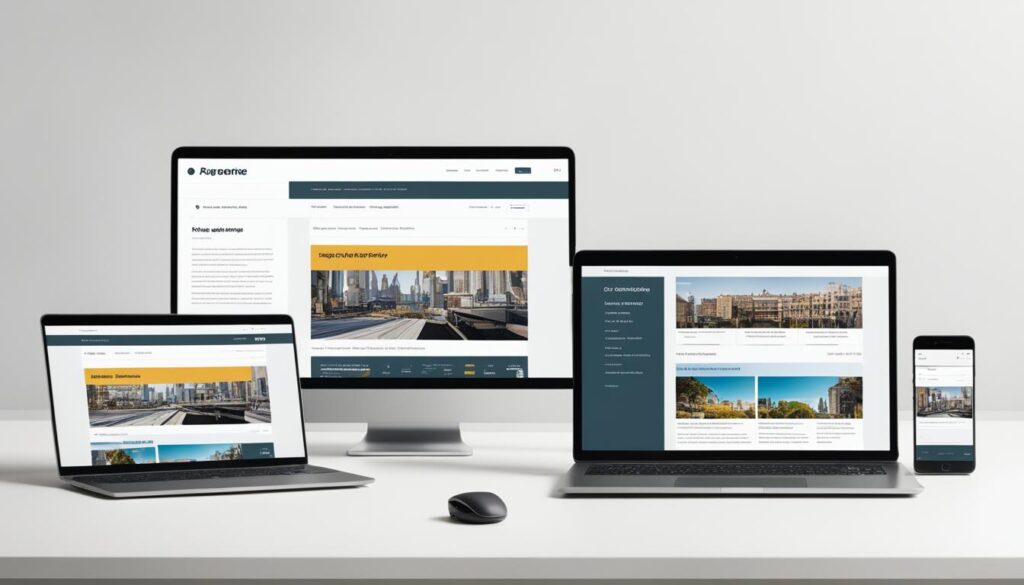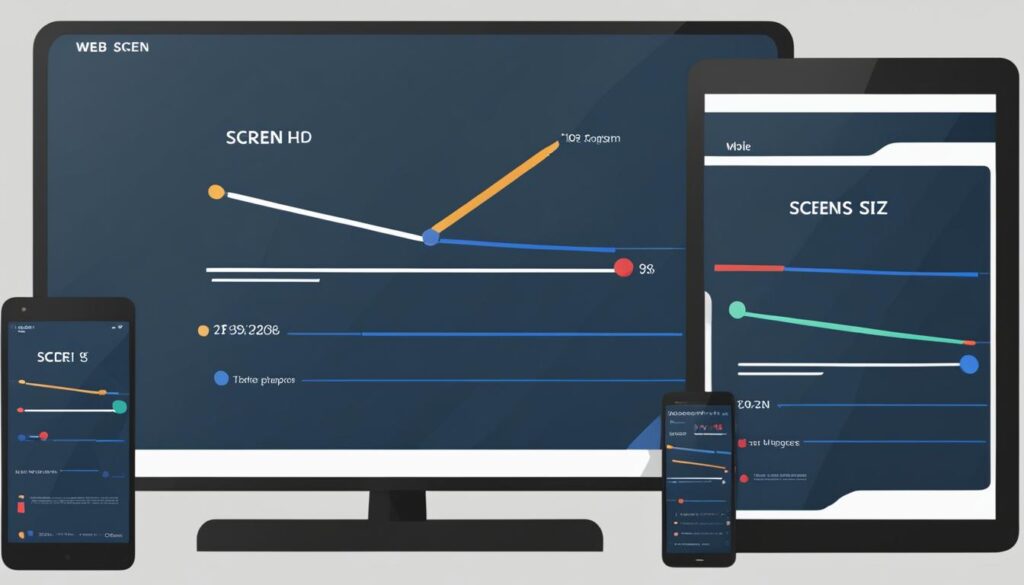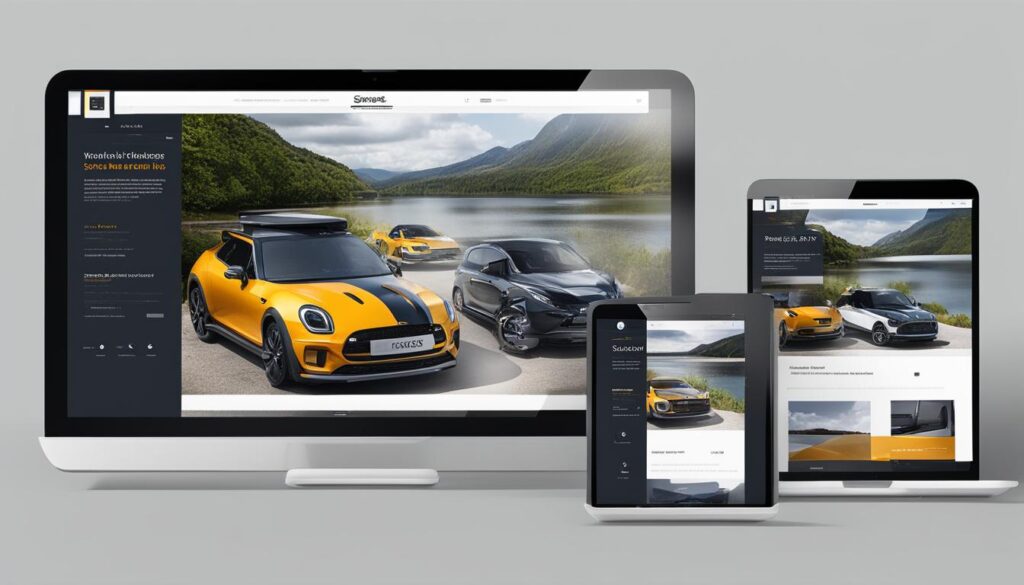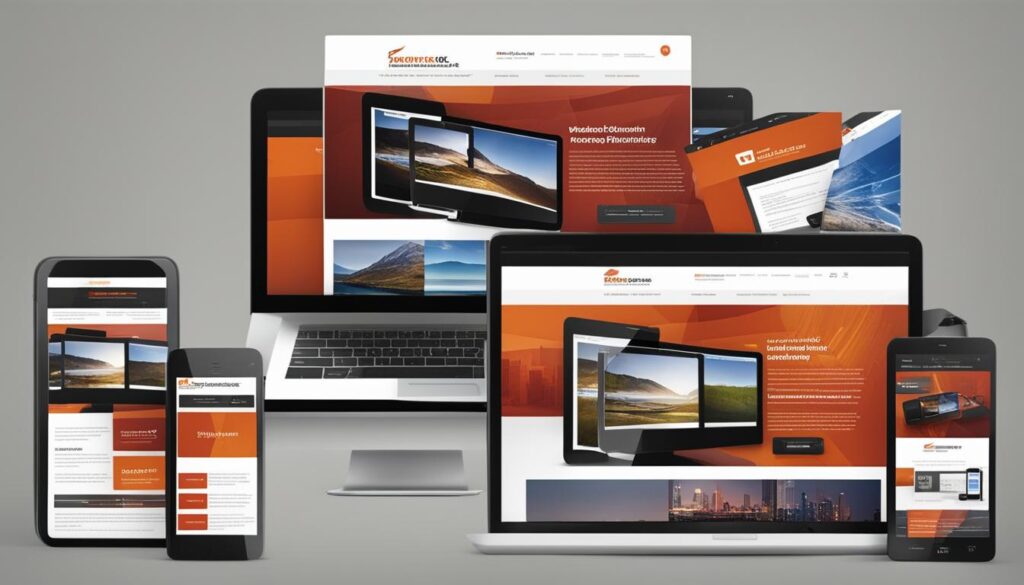Are you wondering what resolution to use for your web design? Look no further, because we have the answers you need. When it comes to creating a visually appealing and responsive website, choosing the right resolution is crucial. It’s essential to design websites that work well on mobile, tablet, and desktop devices, providing an optimal user experience for all visitors.
So, what resolution should you use for web design? Let’s dive in and find out the best practices and guidelines for selecting the optimal resolution for your website.
Key Takeaways:
- Responsive web design is essential for ensuring that your website looks great on different devices.
- Consider the most common screen resolutions for mobile and desktop devices when designing your website.
- Some popular screen resolutions for mobile in 2023 include 360×800, 390×844, 414×896, and 393×873.
- For desktop, the most common screen resolutions are 1920×1080, 1366×768, 1440×900, 1280×720, and 1280×1024.
- Choosing the right screen size is essential for creating a responsive and visually appealing website.
Understanding Responsive Design and Device Fragmentation
Responsive design is an indispensable strategy for ensuring that websites deliver an optimal user experience across various screen sizes, encompassing mobile, tablet, and desktop devices. With the increasing prevalence of different mobile and desktop devices in accessing the internet, it becomes imperative for designers to address the challenges posed by device fragmentation and create responsive designs tailored to meet the unique requirements of diverse users.
One of the key components of responsive design is responsive breakpoints. These breakpoints establish the points at which the content and visual elements of a website adjust to suit different screen sizes. By strategically defining these breakpoints, designers can meticulously tailor the responsiveness of their websites to cater effectively to each specific device.
Device fragmentation refers to the wide array of device types and screen sizes that exist in the digital landscape. From smartphones with compact screens to large desktop monitors, the diversity of devices necessitates comprehensive composure and adaptability within website design. By acknowledging the concept of device fragmentation in responsive design, designers can navigate the intricate interplay between various devices and achieve seamless user experiences regardless of the screen size.
Being familiar with the principles of responsive design and device fragmentation empowers designers to create websites that are attuned to the preferences and behaviours of modern-day users. By ensuring that their designs are responsive and adaptable, designers can deliver consistent and exceptional experiences across the multitude of devices in use today.

Device fragmentation and responsive design go hand in hand in ensuring that websites are accessible, user-friendly, and visually enticing on all devices. By comprehending the significance of responsive design and integrating it seamlessly into web design practices, designers can address the challenges posed by device fragmentation, thereby maximizing the impact of their websites.
Choosing the Right Screen Size for Responsive Design
When it comes to creating a responsive web design, selecting the appropriate screen size is a crucial decision. While there is no one-size-fits-all solution, understanding the popular screen resolutions can help guide your design process. At digital agencies, two common design file resolutions are frequently used as starting points:
- 1440px wide with a main content container of 1140px
- 1920px wide
These resolutions provide a good foundation for designing responsive websites that cater to a wide range of devices. By considering the needs of your audience and the overall design concept, you can make an informed decision regarding the screen size for your responsive design.

The Importance of CSS Grid in Responsive Web Design
In responsive web design, the CSS grid plays a vital role in creating visually stunning and user-friendly websites that adapt seamlessly to different screen sizes. The CSS grid acts as a framework for organizing and structuring the layout of web page content, providing designers with the flexibility to create responsive designs that are dynamic and adaptable.
By using a grid system with a fixed number of columns and gutter space, designers can easily position and align various elements within a web page. This grid system ensures that elements maintain their intended layout and appearance across different devices, such as desktops, tablets, and mobile phones.
With the CSS grid, designers can achieve precise control over the placement and alignment of elements, resulting in visually appealing and well-structured web design layouts. This consistency in alignment and layout is particularly crucial for responsive web design, as it ensures that the content remains accessible and readable, regardless of the device being used.
“The CSS grid allows for the creation of fluid and responsive web designs that adapt organically to different screen sizes.”
By leveraging the CSS grid, developers can efficiently translate the design concept into functioning websites with ease. The grid system simplifies the implementation process, allowing developers to achieve website responsiveness more efficiently and accurately. This ensures that the final product not only meets the aesthetic requirements but also provides an optimal user experience across various devices.
Example CSS Grid Layout:
| Header 1 | Header 2 | Header 3 |
|---|---|---|
| Content 1 | Content 2 | Content 3 |
| Content 4 | Content 5 | Content 6 |
The table above demonstrates a simple CSS grid layout with three columns and two rows. By defining the grid and assigning content to specific cells, designers can create well-structured and responsive web layouts.
In conclusion, utilizing the CSS grid is essential in responsive web design. It empowers designers to create visually appealing and adaptable web layouts, ensuring optimal website responsiveness across different screen sizes. By maintaining consistency in alignment and layout, the CSS grid streamlines the development process and contributes to an enhanced user experience. With its flexibility and precision, the CSS grid is a valuable tool for web designers seeking to create modern, visually appealing, and responsive websites.
Understanding Breakpoints and Screen Sizes in Responsive Design
Breakpoints are key elements in responsive design as they determine the ranges of screen resolutions at which a website’s layout and content will adapt. By setting breakpoints, we can ensure that a website maintains optimal responsiveness across different screen sizes, providing an enhanced user experience. The most common breakpoints include large desktop screens, laptops, tablets, and mobile phones. At each breakpoint, designers have the ability to define specific behaviors, adjusting the layout and content display to ensure readability and usability on various devices.

Benefits of Breakpoints in Responsive Design
Breakpoints offer several advantages in creating a responsive design that caters to diverse devices and screen sizes:
- Accurate Content Presentation: By defining breakpoints, designers can control how content is displayed on different screen sizes, ensuring that the information is presented accurately and effectively.
- Improved User Experience: Responsive design with appropriate breakpoints allows users to navigate and interact with a website seamlessly, regardless of the device they are using.
- Enhanced Website Responsiveness: Breakpoints enable the design to adapt dynamically, optimizing the website’s responsiveness and performance on various devices.
In summary, understanding and implementing breakpoints is essential for achieving effective responsive design. By strategically setting breakpoints, designers can create websites that seamlessly adapt to different screen sizes and deliver an optimal user experience. It is important to consider the unique characteristics of each device and define specific design behaviors at each breakpoint to ensure website responsiveness and usability.
The Impact of Mobile-Friendly Design on Search Rankings
Being mobile-friendly is crucial for search engine optimization (SEO) and improving search rankings. At our company, we prioritize mobile-friendly design to ensure our clients’ websites can reach their target audience effectively. Google, the leading search engine, also values mobile-friendly websites and prioritizes them in its search results.
“Mobile-friendly design is a key factor in determining search rankings, as more users are accessing the internet through mobile devices.”
Google’s Mobile Friendly algorithm update, launched in 2015, marked a significant shift in search rankings. Websites that are not mobile-friendly may experience a decrease in rankings and organic traffic. This makes it essential for businesses to invest in responsive website design that provides a positive user experience (UX) on mobile devices.
A responsive website design ensures that the layout and content of a website adapt smoothly to different screen sizes and resolutions. By providing a seamless user experience across devices, responsive websites stand a better chance of ranking higher in search results.
“Mobile-friendly design is not just about rankings; it’s about providing a positive user experience for your audience.”
Responsive websites offer several benefits beyond improved search rankings. They enhance usability, decrease bounce rates, increase user engagement, and ultimately boost conversions. With more people relying on mobile devices for browsing and online transactions, businesses cannot afford to ignore the importance of mobile-friendly design.
“Google prioritizes mobile-friendly websites because it understands the importance of delivering quality results to its users.”
| Benefits of Mobile-Friendly Design |
|---|
| 1. Improved search rankings |
| 2. Enhanced user experience (UX) |
| 3. Increased user engagement |
| 4. Reduced bounce rates |
| 5. Higher conversion rates |
By aligning with Google’s Mobile Friendly guidelines and adopting responsive design principles, businesses can ensure their websites are optimized for mobile devices. This not only helps in achieving higher search rankings but also delivers a seamless and enjoyable user experience for their target audience.

“Investing in mobile-friendly design is investing in the growth and success of your online presence.”
Determining Your Screen Resolution
Understanding how your website will appear on different devices is essential for ensuring optimal visibility and usability. To determine your screen resolution on a PC, you have a couple of options:
- Right-click on the Desktop: Start by right-clicking on your Desktop and selecting “Display Settings” from the menu. This will open the display settings window where you can view and adjust your screen resolution.
- Online Tools: Alternatively, you can use online tools that help determine your screen resolution. These tools provide a quick and convenient way to find out the resolution of your device without accessing the display settings.
Knowing your screen resolution allows you to design your website with responsive design in mind. By considering different resolutions, you can ensure that your website adapts smoothly across various devices, enhancing website visibility and overall user experience.
| Screen Resolution | Devices |
|---|---|
| 360×800 | Mobile |
| 390×844 | Mobile |
| 414×896 | Mobile |
| 393×873 | Mobile |
| 1920×1080 | Desktop |
| 1366×768 | Desktop |
| 1440×900 | Desktop |
| 1280×720 | Desktop |
| 1280×1024 | Desktop |
By considering these common screen resolutions and determining your own screen resolution, you can create a responsive web design that caters to a wide range of devices and ensures a seamless browsing experience for your visitors.
Best Practices for Responsive Web Design
When it comes to designing a responsive website, there are several best practices to follow in order to create an optimal user experience. By implementing these best practices, we can ensure that our websites are visually appealing, user-friendly, and fully optimized for different devices.
1. Know Your Breakpoints
Understanding the breakpoints in responsive design is crucial for creating a seamless experience across various screen sizes. By identifying the key breakpoints in your design, you can adapt the layout and elements of your website accordingly. This allows for a smooth transition between different devices, ensuring that your content remains readable and accessible on each screen size.
2. Create Fluid Designs
Fluid designs are essential for responsive web design. By utilizing flexible measurements, such as percentages, instead of fixed pixel values, you can create designs that can easily adapt to different screen viewports. This ensures that your website’s layout remains consistent and visually appealing on any device.
3. Decrease Friction
Friction refers to any unnecessary obstacles or hurdles that users may encounter when interacting with your website. In a responsive design, it’s important to minimize friction by streamlining navigation, optimizing load times, and simplifying form filling processes. By reducing friction, you can enhance the overall user experience, resulting in increased engagement and conversion rates.
4. Mobile-First Design
Designing with a mobile-first approach means prioritizing the needs and constraints of mobile users. As mobile devices become the primary means of accessing the internet, it’s crucial to ensure that your website looks and functions flawlessly on smaller screens. By starting with the mobile design and then scaling up to larger screen sizes, you can create a responsive website that caters to the majority of your users.
5. Minimize Typing on Mobile Devices
Typing on mobile devices can be cumbersome and error-prone, so it’s important to minimize the need for extensive typing whenever possible. Implement features such as autocomplete, dropdown menus, and pre-filled forms to streamline user input. By reducing the amount of typing required, you can improve the overall user experience and encourage higher levels of engagement.
| Best Practices | Benefits |
|---|---|
| Knowing your breakpoints | Ensures smooth transitions between devices |
| Creating fluid designs | Adapts to different screen sizes, maintaining consistency |
| Decreasing friction | Enhances user experience and increases engagement |
| Designing with a mobile-first approach | Optimizes the website for mobile users, catering to the majority |
| Minimizing typing on mobile devices | Improves usability and encourages higher engagement levels |
By following these best practices, we can ensure that our websites are responsive, visually appealing, and provide an exceptional user experience across various devices. Implementing these strategies will not only keep our users engaged and satisfied but also contribute to better search rankings and overall business success.

Testing Responsive Design on Real Devices
Testing responsive design is crucial to ensure that a website appears as intended on different devices. It’s important to verify that your website layout, content, and features are responsive and visually appealing across various screen sizes. By conducting responsive design testing, you can identify any layout or compatibility issues and make necessary adjustments to provide a seamless user experience.
Using a Responsive Design Checker
One way to test your responsive design is by using a responsive design checker tool. These tools allow you to preview your website on different devices and resolutions, giving you an idea of how your website appears and functions across various screen sizes. You can quickly identify any design inconsistencies or elements that are not adapting properly.
“Responsive design checker tools provide a convenient way to visually assess your website’s responsiveness without needing physical access to multiple devices.”
By using a responsive design checker, you can ensure that your website looks great and maintains functionality on popular devices, such as smartphones, tablets, and desktops. This allows you to make any necessary adjustments and optimizations before your website goes live.
Real Device Testing Platforms
In addition to using a responsive design checker, it’s also recommended to perform real device testing. Real device testing involves testing your website on actual devices to simulate real-life user interactions. This ensures that you uncover any device-specific issues that may not be visible through virtual testing alone.
A popular platform for real device testing is BrowserStack. BrowserStack provides access to a wide range of mobile and desktop devices, allowing you to test your website’s responsiveness and functionality on different operating systems, screen sizes, and browsers. This comprehensive testing helps you validate your responsive design on real devices and achieve optimal compatibility for your target audience.

Benefits of Testing Responsive Design on Real Devices
Testing responsive design on real devices offers several advantages:
- Identify layout inconsistencies: Real device testing allows you to identify any layout inconsistencies or design issues that may arise on specific devices or screen sizes.
- Verify functionality: Testing on real devices ensures that all interactive elements, such as buttons, forms, and menus, function correctly across various platforms.
- Browser compatibility: Real device testing helps you ensure that your website renders correctly and is compatible with different browsers and versions.
By investing time in testing responsive design on real devices, you can optimize your website’s performance, enhance the user experience, and boost customer satisfaction.
Conclusion
In conclusion, when it comes to achieving optimal web design resolution for responsive design, it is crucial to consider various factors such as the target audience, design concept, and common screen resolutions. By understanding the fundamentals of responsive web design and following the guidelines, we can create visually appealing and responsive websites that adapt seamlessly to different screen sizes, providing an optimal user experience.
Utilizing CSS grid plays a significant role in creating responsive web designs. The grid system helps organize the layout of web page content, ensuring proper alignment and responsiveness. By setting breakpoints and defining specific behaviors for each screen size, designers can ensure that the design and content of the website adapt appropriately to provide readability and usability across various devices.
Real device testing is essential to identify and fix any layout or compatibility issues. By testing responsive design on real devices, we can ensure that the website appears as intended on different devices and resolutions. This testing process helps guarantee compatibility and usability, resulting in a seamless and satisfactory user experience across a wide range of devices.
By following these responsive design guidelines and considering the optimal web design resolution based on our audience and design concept, we can create websites that are not only visually appealing but also provide an optimal user experience on different devices. Responsive design is a crucial aspect of website development in today’s digital landscape, and by prioritizing it, we can meet the needs of our users and enhance the overall success of our websites.
FAQ
What is responsive web design?
Responsive web design is a design strategy that ensures websites adapt well to different screen sizes, including mobile, tablet, and desktop devices. It allows users to have a consistent and optimized browsing experience across various devices.
How do I choose the right screen size for responsive design?
There is no one-size-fits-all solution, but popular screen resolutions like 1440px and 1920px wide are commonly used as starting points. It’s important to consider your target audience and the design concept of your website when selecting the screen size for responsive design.
What role does CSS grid play in responsive web design?
CSS grid provides a framework for organizing the layout of web page content, allowing designers to create responsive designs that adapt to different screen sizes. It helps maintain consistency in alignment and layout, making it easier for developers to translate the design into functioning websites.
What are breakpoints in responsive design?
Breakpoints define the ranges of screen resolutions at which the layout and content of a website will change. They allow designers to ensure that the website’s design adapts smoothly to different screen sizes, providing an optimal user experience.
How does mobile-friendly design impact search rankings?
Mobile-friendly websites are prioritized by search engines like Google, as more users are accessing the internet through mobile devices. Having a responsive website design and providing a positive user experience on mobile devices can significantly impact search rankings and overall website visibility.
How can I determine my screen resolution?
You can easily find out your screen resolution on a PC by right-clicking on the desktop, selecting display settings, and viewing the resolution settings. Alternatively, there are online tools available that can help you determine your screen resolution.
What are the best practices for responsive web design?
Some best practices include knowing your breakpoints, creating fluid designs, decreasing friction for a seamless user experience, designing with a mobile-first approach, and minimizing the need for typing on mobile devices.
How can I test responsive design?
You can use responsive design checkers or real device testing platforms like BrowserStack to see how your website appears on various devices and resolutions. Testing responsive design on real devices is crucial to identify and fix any layout or compatibility issues.

Leave a Reply